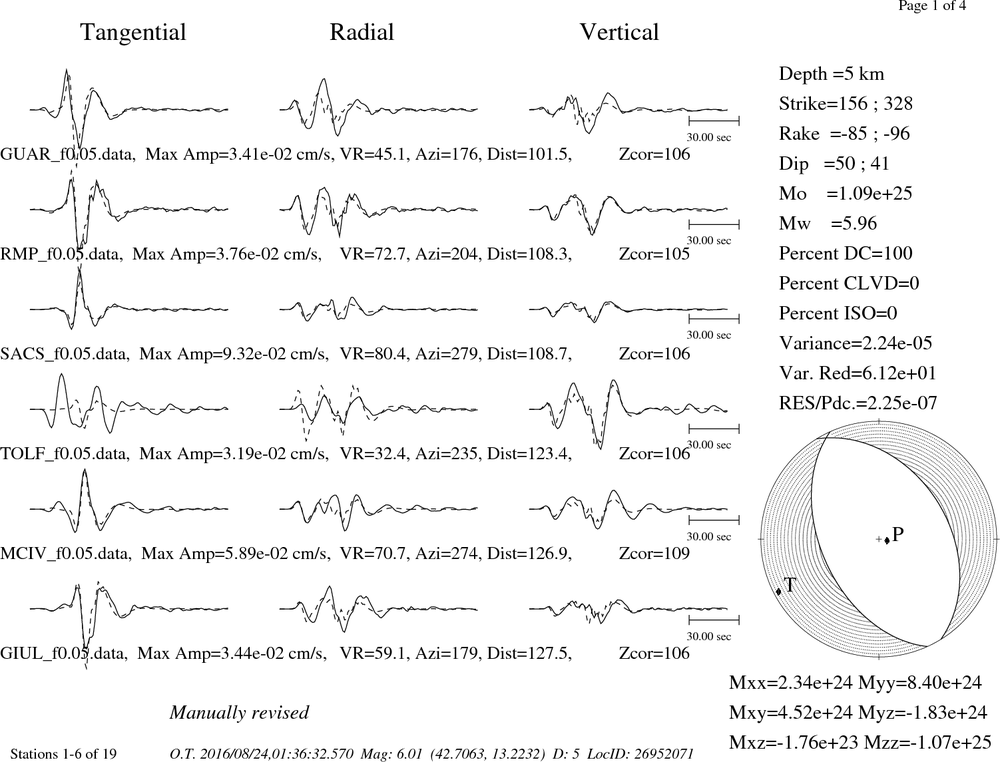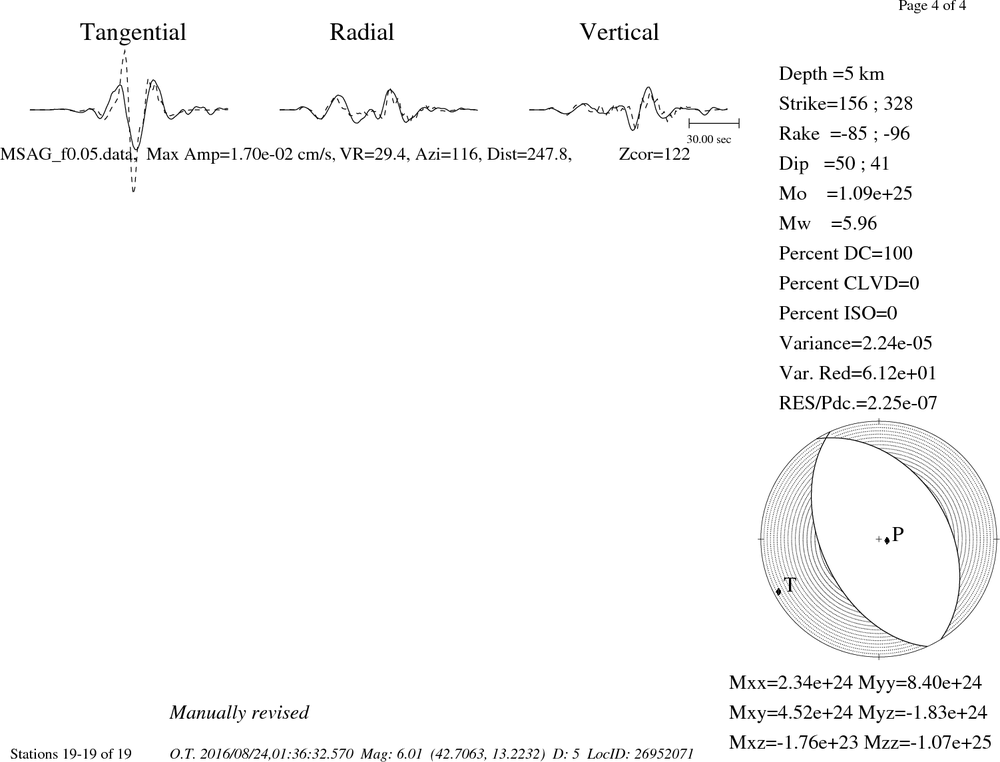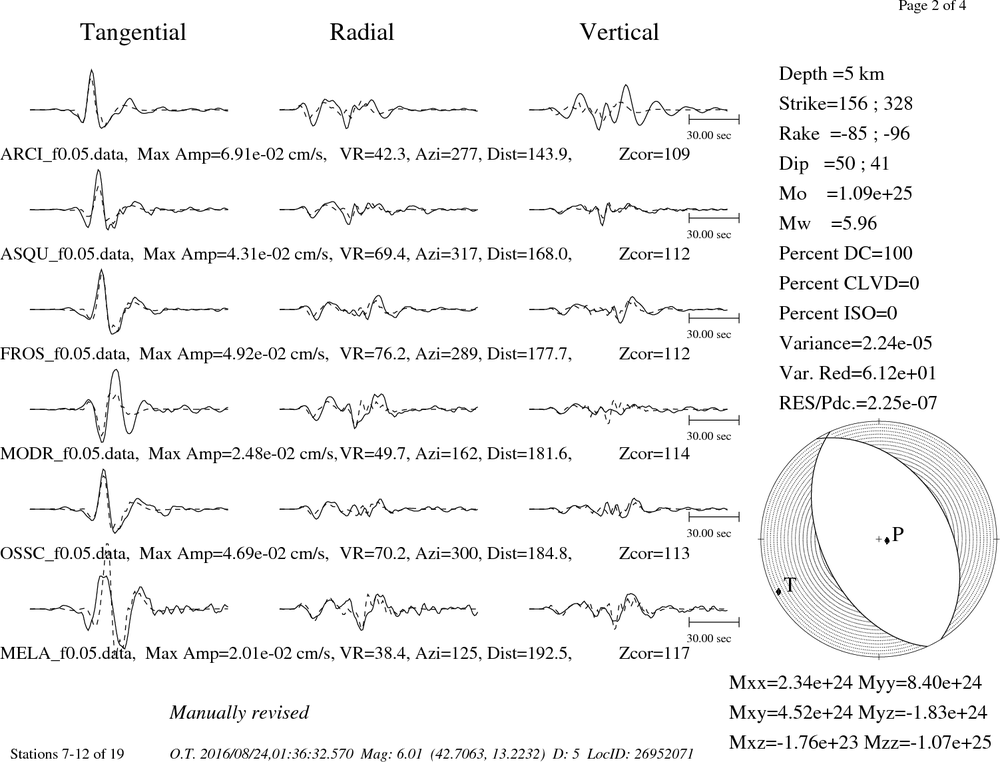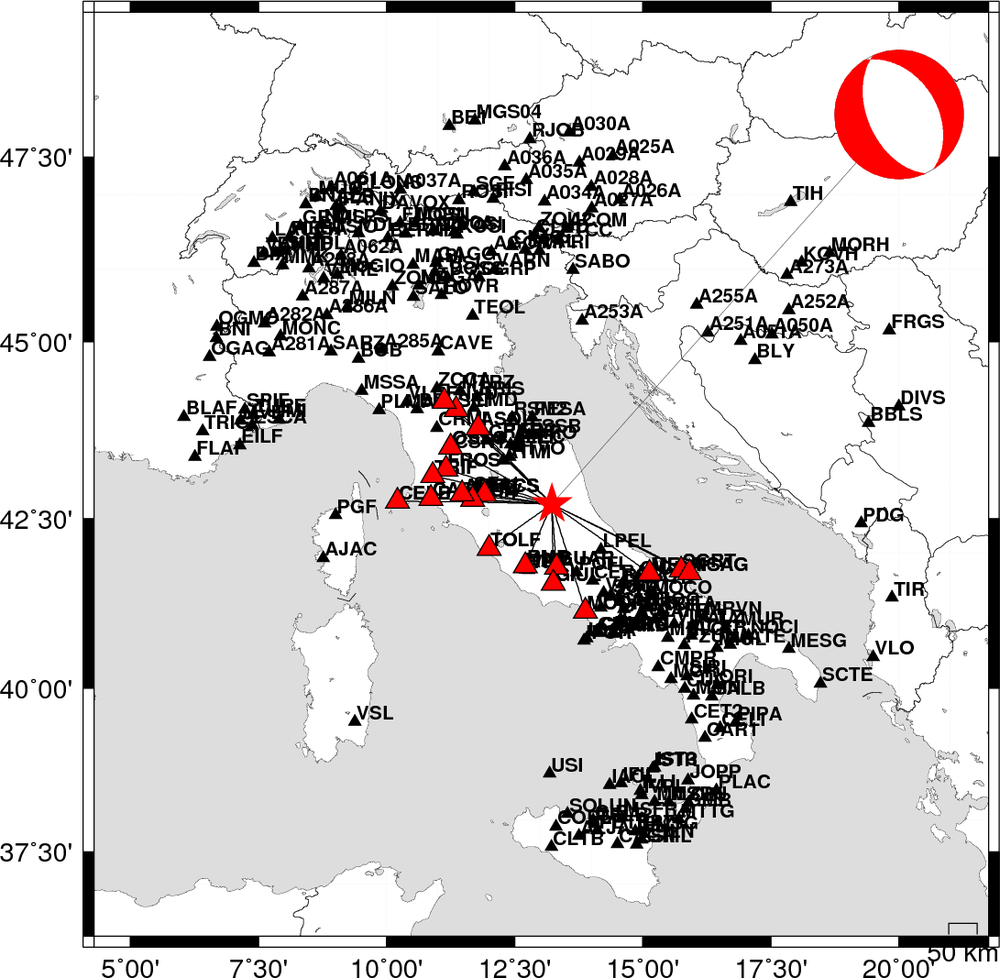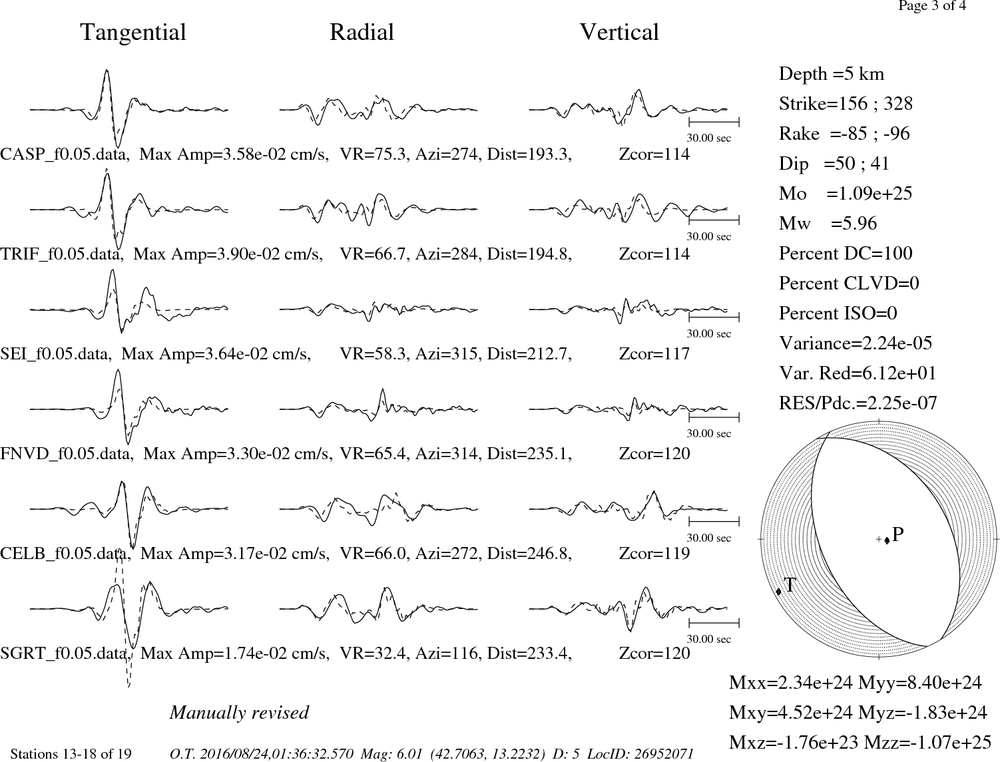Location
2016/08/24 01:36:32 42.7060 13.2230 4.2 6.00
SLU Moment Tensor Solution
ENS 2016/08/24 01:36:32:0 42.71 13.22 4.2 6.0
Stations used:
IV.ARCI IV.CERT IV.CESX IV.FIAM IV.GIUL IV.GUAR IV.GUMA
IV.MA9 IV.MCIV IV.PTQR IV.RMP IV.SACS IV.SNTG IV.SRES
Filtering commands used:
hp c 0.01 n 3
lp c 0.05 n 3
Best Fitting Double Couple
Mo = 1.14e+25 dyne-cm
Mw = 5.97
Z = 5 km
Plane Strike Dip Rake
NP1 155 50 -85
NP2 327 40 -96
Principal Axes:
Axis Value Plunge Azimuth
T 1.14e+25 5 241
N 0.00e+00 4 332
P -1.14e+25 84 100
Moment Tensor: (dyne-cm)
Component Value
Mxx 2.57e+24
Mxy 4.75e+24
Mxz -2.53e+23
Myy 8.57e+24
Myz -2.05e+24
Mzz -1.11e+25
##############
#----#################
####----------##############
####--------------############
#####------------------###########
######--------------------##########
#######---------------------##########
########-----------------------#########
########------------------------########
##########-----------------------#########
##########------------- --------########
###########------------ P ---------#######
###########------------ ---------#######
###########-----------------------######
############----------------------######
#########---------------------#####
T ###########-------------------####
############------------------###
#############---------------##
##############------------##
###############-------
##############
Global CMT Convention Moment Tensor:
R T P
-1.11e+25 -2.53e+23 2.05e+24
-2.53e+23 2.57e+24 -4.75e+24
2.05e+24 -4.75e+24 8.57e+24
Details of the solution is found at
http://www.eas.slu.edu/eqc/eqc_mt/MECH.IT/20160824013632/index.html
|
Preferred Solution
The preferred solution from an analysis of the surface-wave spectral amplitude radiation pattern, waveform inversion and first motion observations is
STK = 155
DIP = 50
RAKE = -85
MW = 5.97
HS = 5.0
The waveform inversion is preferred.
Moment Tensor Comparison
The following compares this source inversion to others
| SLU |
GCMT |
INGVTDMT |
SLU Moment Tensor Solution
ENS 2016/08/24 01:36:32:0 42.71 13.22 4.2 6.0
Stations used:
IV.ARCI IV.CERT IV.CESX IV.FIAM IV.GIUL IV.GUAR IV.GUMA
IV.MA9 IV.MCIV IV.PTQR IV.RMP IV.SACS IV.SNTG IV.SRES
Filtering commands used:
hp c 0.01 n 3
lp c 0.05 n 3
Best Fitting Double Couple
Mo = 1.14e+25 dyne-cm
Mw = 5.97
Z = 5 km
Plane Strike Dip Rake
NP1 155 50 -85
NP2 327 40 -96
Principal Axes:
Axis Value Plunge Azimuth
T 1.14e+25 5 241
N 0.00e+00 4 332
P -1.14e+25 84 100
Moment Tensor: (dyne-cm)
Component Value
Mxx 2.57e+24
Mxy 4.75e+24
Mxz -2.53e+23
Myy 8.57e+24
Myz -2.05e+24
Mzz -1.11e+25
##############
#----#################
####----------##############
####--------------############
#####------------------###########
######--------------------##########
#######---------------------##########
########-----------------------#########
########------------------------########
##########-----------------------#########
##########------------- --------########
###########------------ P ---------#######
###########------------ ---------#######
###########-----------------------######
############----------------------######
#########---------------------#####
T ###########-------------------####
############------------------###
#############---------------##
##############------------##
###############-------
##############
Global CMT Convention Moment Tensor:
R T P
-1.11e+25 -2.53e+23 2.05e+24
-2.53e+23 2.57e+24 -4.75e+24
2.05e+24 -4.75e+24 8.57e+24
Details of the solution is found at
http://www.eas.slu.edu/eqc/eqc_mt/MECH.IT/20160824013632/index.html
|
August 24, 2016, CENTRAL ITALY, MW=6.2
Howard Koss
CENTROID-MOMENT-TENSOR SOLUTION
GCMT EVENT: C201608240136A
DATA: II IU LD CU G IC GE DK XF
KP MN
L.P.BODY WAVES:150S, 338C, T= 40
MANTLE WAVES: 131S, 213C, T=125
SURFACE WAVES: 165S, 429C, T= 50
TIMESTAMP: Q-20160824053527
CENTROID LOCATION:
ORIGIN TIME: 01:36:38.1 0.1
LAT:42.66N 0.00;LON: 13.20E 0.00
DEP: 12.0 FIX;TRIANG HDUR: 3.1
MOMENT TENSOR: SCALE 10**25 D-CM
RR=-2.490 0.010; TT= 0.523 0.011
PP= 1.960 0.010; RT=-0.384 0.031
RP=-0.339 0.029; TP=-1.040 0.009
PRINCIPAL AXES:
1.(T) VAL= 2.509;PLG= 1;AZM= 63
2.(N) 0.074; 11; 153
3.(P) -2.589; 79; 325
BEST DBLE.COUPLE:M0= 2.55*10**25
NP1: STRIKE=142;DIP=45;SLIP=-106
NP2: STRIKE=343;DIP=47;SLIP= -75
--#########
----------#########
#-------------#########
##----------------########
###-----------------####### T
####------------------######
####--------- -------########
#####--------- P --------########
######-------- --------########
#######------------------########
########------------------#######
########-----------------######
#########---------------#######
##########-------------######
###########-----------#####
#############------####
################---
##########-
|
|
Waveform Inversion
The focal mechanism was determined using broadband seismic waveforms. The location of the event and the
and stations used for the waveform inversion are shown in the next figure.

|
|
Location of broadband stations used for waveform inversion
|
The program wvfgrd96 was used with good traces observed at short distance to determine the focal mechanism, depth and seismic moment. This technique requires a high quality signal and well determined velocity model for the Green functions. To the extent that these are the quality data, this type of mechanism should be preferred over the radiation pattern technique which requires the separate step of defining the pressure and tension quadrants and the correct strike.
The observed and predicted traces are filtered using the following gsac commands:
hp c 0.01 n 3
lp c 0.05 n 3
The results of this grid search from 0.5 to 19 km depth are as follow:
DEPTH STK DIP RAKE MW FIT
WVFGRD96 1.0 170 50 -65 5.78 0.5617
WVFGRD96 2.0 165 50 -70 5.83 0.6245
WVFGRD96 3.0 155 50 -85 5.89 0.6674
WVFGRD96 4.0 150 50 -90 5.93 0.6769
WVFGRD96 5.0 155 50 -85 5.97 0.7180
WVFGRD96 6.0 150 50 -90 5.97 0.6555
WVFGRD96 7.0 155 55 -85 5.96 0.5650
WVFGRD96 8.0 195 75 -30 5.85 0.5025
WVFGRD96 9.0 195 70 35 5.86 0.5123
WVFGRD96 10.0 195 70 35 5.87 0.5232
WVFGRD96 11.0 195 70 35 5.88 0.5316
WVFGRD96 12.0 195 70 35 5.88 0.5378
WVFGRD96 13.0 195 70 35 5.89 0.5437
WVFGRD96 14.0 195 70 35 5.90 0.5485
WVFGRD96 15.0 190 70 40 5.92 0.5481
The best solution is
WVFGRD96 5.0 155 50 -85 5.97 0.7180
The mechanism correspond to the best fit is

|
|
Figure 1. Waveform inversion focal mechanism
|
The best fit as a function of depth is given in the following figure:

|
|
Figure 2. Depth sensitivity for waveform mechanism
|
The comparison of the observed and predicted waveforms is given in the next figure. The red traces are the observed and the blue are the predicted.
Each observed-predicted component is plotted to the same scale and peak amplitudes are indicated by the numbers to the left of each trace. A pair of numbers is given in black at the right of each predicted traces. The upper number it the time shift required for maximum correlation between the observed and predicted traces. This time shift is required because the synthetics are not computed at exactly the same distance as the observed and because the velocity model used in the predictions may not be perfect.
A positive time shift indicates that the prediction is too fast and should be delayed to match the observed trace (shift to the right in this figure). A negative value indicates that the prediction is too slow. The lower number gives the percentage of variance reduction to characterize the individual goodness of fit (100% indicates a perfect fit).
The bandpass filter used in the processing and for the display was
hp c 0.01 n 3
lp c 0.05 n 3

|
|
Figure 3. Waveform comparison for selected depth. Red: observed; Blue - predicted. The time shift with respect to the model prediction is indicated. The percent of fit is also indicated.
|

|
|
Focal mechanism sensitivity at the preferred depth. The red color indicates a very good fit to thewavefroms.
Each solution is plotted as a vector at a given value of strike and dip with the angle of the vector representing the rake angle, measured, with respect to the upward vertical (N) in the figure.
|
A check on the assumed source location is possible by looking at the time shifts between the observed and predicted traces. The time shifts for waveform matching arise for several reasons:
- The origin time and epicentral distance are incorrect
- The velocity model used for the inversion is incorrect
- The velocity model used to define the P-arrival time is not the
same as the velocity model used for the waveform inversion
(assuming that the initial trace alignment is based on the
P arrival time)
Assuming only a mislocation, the time shifts are fit to a functional form:
Time_shift = A + B cos Azimuth + C Sin Azimuth
The time shifts for this inversion lead to the next figure:

The derived shift in origin time and epicentral coordinates are given at the bottom of the figure.
Discussion
Velocity Model
The nnCIA used for the waveform synthetic seismograms and for the surface wave eigenfunctions and dispersion is as follows:
MODEL.01
C.It. A. Di Luzio et al Earth Plan Lettrs 280 (2009) 1-12 Fig 5. 7-8 MODEL/SURF3
ISOTROPIC
KGS
FLAT EARTH
1-D
CONSTANT VELOCITY
LINE08
LINE09
LINE10
LINE11
H(KM) VP(KM/S) VS(KM/S) RHO(GM/CC) QP QS ETAP ETAS FREFP FREFS
1.5000 3.7497 2.1436 2.2753 0.500E-02 0.100E-01 0.00 0.00 1.00 1.00
3.0000 4.9399 2.8210 2.4858 0.500E-02 0.100E-01 0.00 0.00 1.00 1.00
3.0000 6.0129 3.4336 2.7058 0.500E-02 0.100E-01 0.00 0.00 1.00 1.00
7.0000 5.5516 3.1475 2.6093 0.167E-02 0.333E-02 0.00 0.00 1.00 1.00
15.0000 5.8805 3.3583 2.6770 0.167E-02 0.333E-02 0.00 0.00 1.00 1.00
6.0000 7.1059 4.0081 3.0002 0.167E-02 0.333E-02 0.00 0.00 1.00 1.00
8.0000 7.1000 3.9864 3.0120 0.167E-02 0.333E-02 0.00 0.00 1.00 1.00
0.0000 7.9000 4.4036 3.2760 0.167E-02 0.333E-02 0.00 0.00 1.00 1.00
Quality Control
Here we tabulate the reasons for not using certain digital data sets
The following stations did not have a valid response files:
DATE=Fri Aug 26 07:47:38 CDT 2016
Last Changed 2016/08/24
